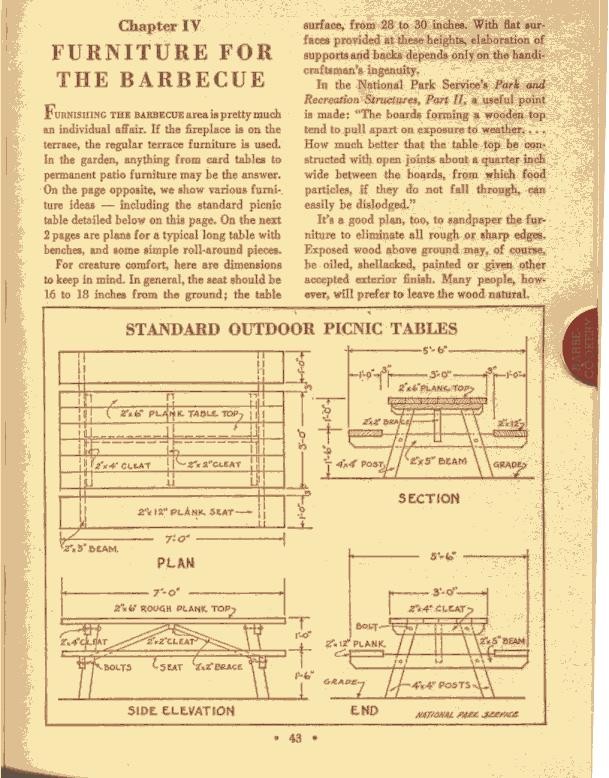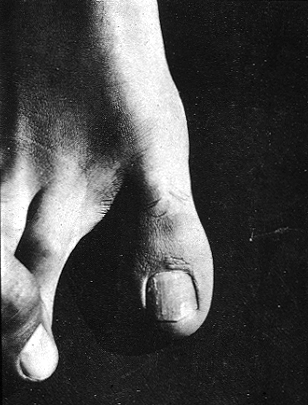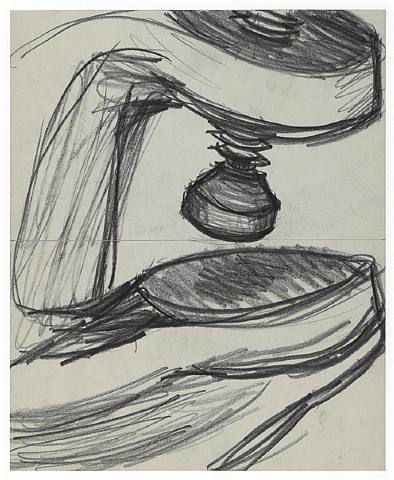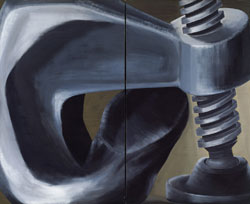Schwarz
View current page
...more recent posts
jesus boots
exhaust fan, kitchen at falling water house
Cherokee Red (Pittsburgh Paints Color #6432-7) - Often referred to as Frank Lloyd Wright's personal favorite, Cherokee Red is perhaps the most famous color at Fallingwater, and was used to coat most of the home's metal and ironwork. Wright is said to have limited his use of Cherokee Red at Fallingwater to metal accents because steel and iron are products of iron ore created through fire.
the realist archive project
via things
The year 2008 marks the 10th Anniversary of the iMac, the computer that changed everything at Apple, hailing a new design era spearheaded by design genius Jonathan Ive. What most people don't know is that there's another man whose products are at the heart of Ive's design philosophy, an influence that permeates every single product at Apple, from hardware to user-interface design. That man is Dieter Rams, and his old designs for Braun during the '50s and '60s hold all the clues not only for past and present Apple products, but their future as well:via nook and justin
When you look at the Braun products by Dieter Rams—many of them at New York's MoMA—and compare them to Ive's work at Apple, you can clearly see the similarities in their philosophies way beyond the sparse use of color, the selection of materials and how the products are shaped around the function with no artificial design, keeping the design "honest."
This passion for "simplicity" and "honest design" that is always declared by Ive whenever he's interviewed or appears in a promo video, is at the core of Dieter Rams'
exile outakes
otis found this one
the life and times of otis ball
Researchers in Florida are growing new coral and transplanting it onto damaged reefs. They're using techniques developed, not by a marine scientist, but by the owner of a tropical fish company. With $3 million in stimulus money from the federal government, the project is being expanded.
There are many situations where a property can be enhanced by creating a useable space from a redundant upper level, however a consistent factor is limited space. The introduction of a staircase to provide access to a proposed upper level will invariably compromise the floor space below where originally no stair was intended.justin found this one
hippiesrus
The scum has killed dozens of dogs over the years - including at least four in Oregon, three in Wisconsin and one in Minnesota this summer. Wisconsin wildlife experts are warning duck hunters with dogs to be extra cautious this fall. "If the water is pea-soup green, be sure to have clean water along to wash the dog off," Vennie said. "Don't let it drink the water."
Fewer than 100 lakes in Wisconsin typically have some problems with algae bloom each summer and the ones in western Wisconsin causing so much discomfort this year are being fueled by a perfect storm, Vennie said. The last month has seen little rain, warm, sunshiny days and little wind.
The blooms just sit there, growing, then decaying and smelling.
"Some people say they have gotten nauseous and vomited from smelling it," said Ken Schreiber, a Wisconsin Department of Natural Resources water quality specialist.
Officials have banned recreational activities at some lakes in Washington state because of blooms. And in Oregon, the blue-green algae is the number one water quality issue, Carmichael said.
Yet other countries have worse problems, Carmichael said, because many have waters with even more nutrients than exist in U.S. lakes.
In France, a horse died on a beach in July after falling into some decaying algae sludge. Last year, the Chinese government brought in the army to remove the slimy growths so the Olympic sailing competition could be held.
Stephanie Marquis, a spokesman for the Wisconsin Department of Health Services, said her agency had received 41 complaints related to health concerns with blue-green algae so far this season. Rashes, sore throats and eye irritation among the problems, she said.
ken burns national parks 12 hrs in 6 parts - check your local listings
alibris just sent me an email suggesting i buy the following book from them:
Manufacturing Consent: The Political Economy of the Mass Media
is this a trick?
rock and roll from the tv and movies - do you have 7:45 to let jerry lee shake it?
A girl and a gun? An appreciation of Hollis Frampton's cinema begins with the admission that a film requires something far simpler than Jean-Luc Godard's basic recipe. Frampton, who died in 1984 at age 48, thought the perfect film would project a rectangle of white light. "But we have decided that we want to see less than this," says Frampton's narrator in his statement of principles/performance piece A Lecture. "Very well."
Frampton may have decided it was foolish (and, on a basic cognitive level, impossible) to deny audiences the familiar and expected pleasure of narrative--none of his films resemble that Platonic ideal of white light. (nostalgia), his best-known film and a clear masterpiece, presents a familiar autobiographical scheme, as the narrator reminisces over a series of thirteen photographs. But the presentation is dissonant, and the viewer is only gradually taught how to watch the film. The photographs disintegrate into ashes on a hot plate, beginning with "the first photograph I ever made with the direct intention of making art" and ending with something that makes him believe "I shall never dare to make another photograph again." So explains the narrator, who in the first deliberate act of misdirection is not Frampton but his friend the Canadian filmmaker Michael Snow. (The voiceover gets exceedingly nested when Snow, narrating for Frampton, refers to Snow, saying with resignation, "I wish I could apologize to him.") He perpetually refers to the forthcoming photograph rather than the one smoldering before the viewer's eyes, creating a disjunction between sound and image. As soon as a new image appears, we are trying to reconcile it with the previous vignette while simultaneously listening to the narrator's recollections and regrets. In other words, we can't help but experience nostalgia. The result is alienating but rarely frustrating. (nostalgia) is a poignant depiction of the elusive nature of memory, even in an age of mechanical reproduction, as well as a deadpan prank. The critic Michael Joshua Rowin has referred to the film's final sequence--which hints at a terrifying mystery in the next photograph, one we will never see--as a three-minute retelling of Michelangelo Antonioni's Blow-Up.
not too much web documentation of national lampoons foto funnies. the series usualy involved a nude woman dropped in to some mans world situation. the format was a photographic interpretation of comic strip (funny paper or funnies) story frames. by this time in the early 70's underground comix and doonsberry * had helped re established an adult interest in the serial frame comics reading format. i offer this posting in connection to sally mccays recent academic style essay on GIF art. in connection to GIF etymology in general and specifically LM's mention [ "I find viewing films frame by frame much more formally interesting than looking at the perfect illusion of motion that they result in." ] of her GIFs distance from animated cinematic smoothness. rather a jumpy connected rhythm of readable narrative. a sort of splitting the difference between unique ideas established per (comic strip) frame and the cinematic
ease in viewing of a full rate of fps ** film experience.
* there were many soap opera / adult interest type series runing in daily news papers ie steve canyon and apartment 3-d.
** muybridge
the cavemen on gimmick rock
the umbrella house sarasota fla
ree
tv cello (1984) "can we get paris?" "yes."
portsmouth sinfonia hall of the mountain king
chris burden beam drop
the paper dress
yellow pages and campbells soup
whaledreamers
Lee Lozano isn't exactly a household name--even in art houses. But in the 1960s and early '70s, she was very much part of New York's art scene; she knew everyone and is remembered as an intense and engaging figure (her inamorati included such diversely talented men as Dan Graham and Joey Ramone). To say the least, Lozano had a strange--and brief--career; though lasting just over a decade, it encompassed a series of distinct styles and practices. For several years, she exhibited regularly, including group shows at Richard Bellamy's Green Gallery in 1964 and 1965. Later she distanced herself from the art world before finally dropping out altogether.
self-kleptomania
flip book animation fps
value theory
the americans
Mountain Retreat in Queenstown / New Zealand by Fearon Hay Architects
justin found this and its stunning
(from the collection of) olivier mossett "Portrait de l'artiste en motocycliste" October 11th at the Centre National d'Art Contemporain de Grenoble
(pdf) press release with dialog between bob nickas and olivier. (highly recommended reading for enthusiasts of one-color paintings and found object art.)
nyt maine cabin construction diary
people of walmart
via adman
the wtc a building project like no other
via things and reference library

norms picnic table plans
big slabs
house dijk
Nonetheless, it was nearly impossible, while sitting in the dark watching it all unfold, not to think that it wasn't just Julius Shulman who was being eulogized and laid symbolically to rest. It was also a certain attitude about what Los Angeles means, here and abroad, and how photographers and architects alike ought to frame life in the city.
After all, in the years before his death Shulman was the greatest living symbol of the idea that Los Angeles and its architecture were synonymous with both expansion and innovation. In that sense, the memorial was another bit of evidence that L.A. is getting a little worse at crafting the future -- as icons of invention like Shulman pass into history -- and a little better at talking about and understanding itself. We are slowly trading initiative for perspective, which is perhaps the fate of any big city as it settles into middle age.
Nearly every speaker touched on Shulman's innate and irrepressible optimism, which was a fundamental element not just of his personality but also of his work. His famous black-and-white photographs of designs by Richard Neutra, Pierre Koenig, Gregory Ain and many others were not just, as Hines noted, marked by clarity and high contrast. They were also carried aloft by a certain airiness of spirit, a lively confidence that announced that Los Angeles was the place where architecture was being sharpened and throwing off sparks from its daily contact with the cutting edge.
Indeed, Shulman's great success was due in part to the fact that he came of age in a period when there was no barrier between the idea of promoting Los Angeles and of uncompromised architectural creativity. Usually these two notions are locked in at least a symbolic struggle: The businessman is the enemy of the artist, and where profit and growth take root they unavoidably crowd out the flowering of authentic creativity.
Certainly, by the 1970s, many of our most talented architects had begun to adopt that attitude, designing buildings that aimed to subvert mass culture or crass profiteering or at least reflect the tensions and inequities in contemporary society. Shulman's Los Angeles -- particularly the quickly expanding city he documented in the 1940s, '50s, and '60s when he was in his prime -- was by contrast a place where business directly fueled artistic and architectural creativity and vice versa, often without guilt or any sense of contradiction.
Shulman saw himself as a working photographer first, a booster for Los Angeles second and an artist not at all; many of Sunday's speakers, including his daughter, Judy McKee, remarked that Shulman was surprised (though also partly vindicated) near the end of his life when his work was discovered and promoted as art by gallery owners, curators, collectors and publishers.
funky diva marva whitney interviewed by michael shelly on wfmu
the bedminster inn re listed at 595k
the national hotel and the rathskeller, frenchtown nj
mayne's 41 cooper sq
british library archival sound recordings blog
via things mag
rebuilding a digital rome
To which Marcantonio, at 4:52 p.m., posts in rejoinder: "Hemingway did not break completely with the past. His prose is stripped, unornamented and spare, but it's legible and there's a recognizable narrative. Its architectural equivalent is this: [Here Marcantonio inserts a photograph of Erik Gunnar Asplund's Stockholm public library, in a pre-modernist style largely stripped of ornament.]"
"Stein," he continues, "comes much closer to pure modernism -- not totally, as she uses recognizable words; however, her sentences really capture a modernist spirit. For example, in Tender Buttons we read: 'A kind in glass and a cousin, a spectacle and nothing strange in a single hurt color and an arrangement in a system to pointing. All this and not ordinary, not unordered in not resembling. The difference is spreading.'
"That," Marcantonio adds, "is essentially meaningless, only conveying the vaguest of sentiments. And it's intended to be meaningless. And I would argue that this type of stuff has absolutely not made writing better. If anything, it's used as a stick to defend illiteracy. The architectural equivalent is this: [Here Marcantonio inserts a photo of founding modernist Le Corbusier's chapel at Ronchamp, France, which looks like a rhinoceros], only Stein's work is superficially prettier and less threatening."
Graffiti Charges Against Yoshitomo Nara Officially Dropped 08.31.09via vz
Yoshitomo Nara, a multimillionaire pop artist, was arrested in February when cops spotted him drawing a smiley face on the wall of the First Avenue L-train stop with a marker in the wee hours of the morning. The art sensation, whose works of doe-eyed cartoonish children have sold for as much as $1.5 million, was given an adjournment in contemplation after being charged with making graffiti and criminal mischief and spending the night in jail. That meant if he kept his nose clean for six months, the charges would be dropped—which they were yesterday. “This case in now officially over,” said his lawyer, Guy Oksenhendler. The incident happened on the eve of the opening for an exhibit of his work at the Marianne Boesky Gallery in Chelsea. The forty-nine-year-old, who lives in Tochigi, Japan, called the arrest “a nice experience in my life,” in which he got to meet people he would not otherwise have encountered. “Like in the movies,” he told Art in America magazine. The always cash-strapped Metropolitan Transit Authority missed an opportunity to make some money off the incident—their efficient employees wiped the graffiti off the wall. It's been estimated the brick it was on could have been sold for ten thousand dollars.
Norman E. Borlaug, the plant scientist who did more than anyone else in the 20th century to teach the world to feed itself and whose work was credited with saving hundreds of millions of lives, died Saturday night.via vz
weird book room
via ree
Ledger Live: Historical Corruption Tour of Jersey City
The horrors of Sept. 11, 2001, are still vivid for many Americans, especially the families of the victims. So it is tragic that on this Sept. 11, when family members, politicians and visitors go to the ceremonies at ground zero, they will be gathering at an unfinished place.
Instead of the two memorial pools designed by the architect Michael Arad, visitors will see their barest outlines. Instead of a circle of skyscrapers, the steel for the tallest tower stretches only five stories high. There are just the first skeletal signs of Santiago Calatrava’s magnificent transportation hub.
Why is it taking so long? That is a question that has been asked every Sept. 11. For the first few years, there were too many feuds — the architects Daniel Libeskind versus David Childs, the families versus the designers and builders, the community versus the demolition squads, the developer Larry Silverstein versus the insurance companies. Even now, Mr. Silverstein is locked in arbitration with the Port Authority of New York and New Jersey, the owner of the site, because he wants more of the authority’s money to build more office towers.
Mayor Michael Bloomberg, who now supports Mr. Silverstein’s excessive demands for public funds, once recognized the hazards of overbuilding office space in the area. In December 2002, a year after the attack, he bluntly acknowledged that “the twin towers’ voracious appetite for tenants weakened the entire downtown real estate market” — a possibility that today’s real estate experts fear if Mr. Silverstein builds too precipitously.
Maybe the best news about Ground Zero on this September 11th, eight years after the September 11th, is that the world no longer seems to rise and fall on what happens there. That’s good, because eight years later, so few of the promises made for the redevelopment of the site have been kept. Yes, the memorial and its related museum are progressing, slowly but surely, at high cost but reasonably close to the original design, and there is even a chance that they will be finished in 2011, in time for the tenth anniversary of the terrorist attacks. And the huge skyscraper that, thankfully, no one any longer seems to call the Freedom Tower is rising, to almost no one’s admiration or gratitude. Now named 1 World Trade Center, it is a banal building designed, it would seem, more by security consultants than by its architect, David Childs, of Skidmore, Owings & Merrill. (The fifty-two-story tower across the street from Ground Zero, called 7 World Trade Center and finished in 2006, was also designed by Childs, and is proof that he can do much better when he is left alone.)
As for the rest of the place—the office towers by Fumihiko Maki, Richard Rogers and Norman Foster, the transit hub by Santiago Calatrava, and the performing arts building by Frank Gehry—almost everything is on hold, thanks to a combination of money and political problems. So is another office building by Kohn Pedersen Fox that is to replace the damaged Deutsche Bank building, whose problem-ridden demolition has taken far longer than its construction did in the early nineteen-seventies. (Then again, the whole rebuilding looks like it is going to take at least twice as long as the original World Trade Center took to build.) Nobody can agree on who is going to pay for all these office towers, which in this economy are the last thing Lower Manhattan needs. So the fighting isn’t a matter of who is going to profit from these new buildings—the state, the Port Authority, or the developer of the site, Larry Silverstein—as it is a question of who is going to bear the cost of having them empty. That’s what all the high-minded ambition for Ground Zero has come to.
fall 09 rago modern auction catalog
hickorees / note the all weather note pads from rite in the rain / lots of old timey good stuff here
thx vz
Among the traditional brick and clapboard structures that line the streets of this sleepy East Texas town, 70 miles north of Houston, a few houses stand out: their roofs are made of license plates, and their windows of crystal platters.thx vz
They are the creations of Dan Phillips, 64, who has had an astonishingly varied life, working as an intelligence officer in the Army, a college dance instructor, an antiques dealer and a syndicated cryptogram puzzle maker. About 12 years ago, Mr. Phillips began his latest career: building low-income housing out of trash.
janis joplin serigraph / crumb on joplin
the mechanical philosopher
knurled knobs - pronounced with hard k's
wtc crap given away as memorial monuments (ad hoc anthony caros ?)
As the anniversary of the attacks of Sept. 11, 2001, approaches on Friday, pieces of the World Trade Center rubble from that day have never been more accessible. A new campaign is under way to speed up the process and increase the volume of giving away pieces of steel big and small from the debris.
The Port Authority of New York and New Jersey, which owns the steel, will invite police and fire departments and mayors and other leaders of cities and towns throughout the country to ask for pieces for memorials. The Port Authority has filled about 25 requests in the last year, and has about a dozen more pending. In recent weeks, trucks have hauled twisted steel columns that weigh hundreds of pounds to York, Pa., and Westerville, Ohio. A smaller piece was shipped to the Air Defense offices of the United States Air Force in Rome, N.Y.

Jacques Andre Boiffard, Untitled, Big Toe series, for Documents, 1929
Attached to the choo-choo train of history the angelic aspect of Pollock's use of line was, for Clem, registered in the flight it could take, the statement it could make against the realm of matter and substance, and thus the sublimation it could perform.
I have been reading Rosalind Krauss' The Optical Unconscious (1993) and enjoying it very much. The above quote (from pg.290) made me laugh. Choo-choo train of history? Ouch! The way she argues with Clement Greenberg is highly charged. She's mean, and I suspect that was one way of getting through to the man, speaking his language. Of course, her arguments are not really addressed to Greenberg. Her goal isn't to convince him (she's not delusional), nor even, ultimately, to taunt him, but to assert her own paradigm for assessing works of modern art. Not only does she dissemble his theoretical positions with cogent argument, but she does so on his rhetorical terms. If one can talk of "owning" when it comes to shared cultural ideas, Greenberg is widely understood to "own" high modernism. But Krauss would beg to differ. Modernism isn't Greenberg, it's an historical era and Krauss has her own compelling version of events.
In the politics of art, she had helped Morris Louis' widow unroll his canvases, enjoyed a collaborative relationship with Kenneth Noland and was championed as an original by Clement Greenberg. Precisely because she worked so intensively and personally on her sculptures, Anne [Truitt] was dismissed by Minimalists such as Donald Judd for being too subjective (and, of course, too female) to create true "specific objects." Anne was deeply respectful of her dealer, Andre Emmerich, who criminally ignored her for a long time, giving her the occasional show, but little practical assistance.
In the studio, Anne was painstaking to a fault, finding the right piece of wood, sanding it for months to the point where it could properly absorb and reflect her chosen color and then applying layer upon layer of paint in order, counterintuitively, to achieve maximum transparency. The tiny bands of color at the base of her sculptures, which were subsequently borrowed by Haim Steinbach for his marvelous series of black paintings, were a clue to their meaning. There are two interpretive elements to Truitt's sculpture, a forbidding armor which blocks out the viewer at first glance and then a slowly revealed intimacy which invites further discovery.
little green men
10 houses made from unorthodox materials
via jbf
remembering dash snow
WHO would have guessed that the quintessential California hot rod, the “stroked-and-bored” Ford with a “competition clutch and four on the floor” canonized by a fast-rising surf band early in the 1960s, was actually the realized dream of a Detroit teenager?via adman
As is the case with so many other icons of popular culture, the legend and the facts surrounding this two-door 1932 Ford are an imperfect match.
This much is certain: The car that became an emblem of Southern California’s surf-and-speed culture as the model for the Beach Boys’ “Little Deuce Coupe” album cover is comfortably retired in Michigan, restored to period-correct glory and repatriated with the family of its builder.
Seeing the car firsthand is a reminder that record promoters have sometimes been known to take liberties. While the catchy Beach Boys lyrics praised a Ford flathead V-8, the album’s cover car was actually powered by an overhead-valve Oldsmobile engine, and its transmission was a three-speed, not the four on the floor of the hit single.
rip ellie greenwich singular songwriter
obit / archived stream gaylords radio tribute show






